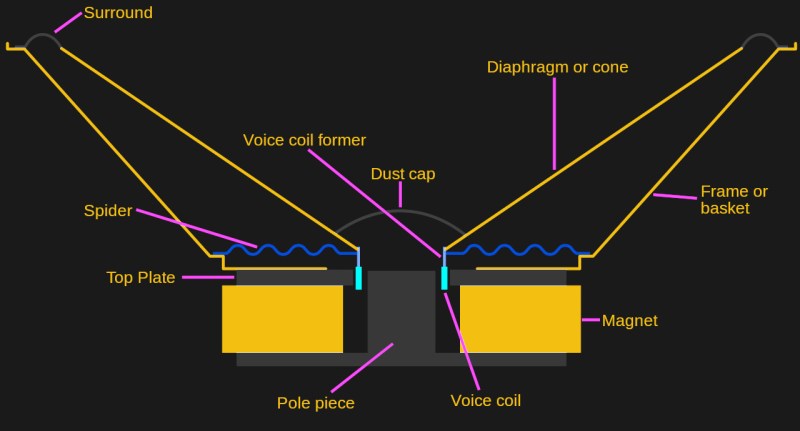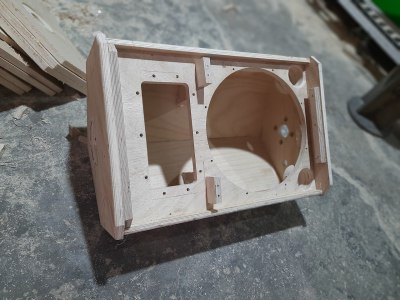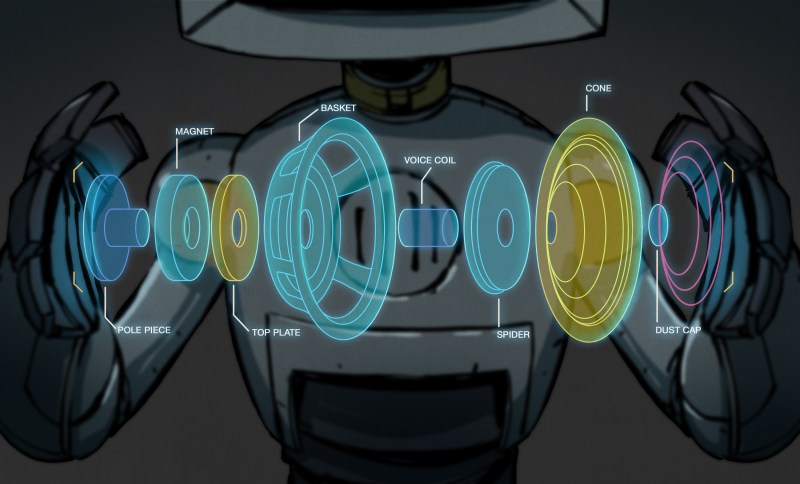As we’ve started out on our journey through the world of Hi-Fi audio from a strictly practical and engineering viewpoint without being misled by any audiophile woo, we’ve already taken a look at the most important component in any audio system: the listener’s ear. It’s time to move down the chain to the next link; the loudspeaker.
Sound is pressure waves in the air, and the purpose of a loudspeaker is to move the air to create those waves. There are a variety of “exotic” loudspeaker technologies including piezoelectric and electrostatic designs, here we’ll be considering the garden variety moving-coil speaker. It’s most usually used for the large bass or smaller mid-range drivers in a typical speaker system.

A moving coil speaker has a lightweight cone suspended by a flexible coupling round its edge, with a coil of electrical wire near its point that sits within a powerful magnetic field. Applying an electric current in one direction moves it outwards, in the other direction inwards. Applying an alternating electric current to it causes it to vibrate, and the resulting air movement causes creates sound. There are as many variations on the basic idea as there are loudspeaker designers, but it’s usual for the cone and flexible coupling to be retained in an open-backed metal frame that also holds the magnet, and for the cone to be made of some form of stiffened paper.
Infinitely Baffled
Try to play a loudspeaker sitting in free air, and you’ll find its sound to be underwhelming. The speaker is producing pressure waves from the rear and from the front, 180 degrees out of phase and interfering with each other. The result is something of a mess, and especially the lower frequencies will cancel out. Some means of isolating front sound from rear sound is called for, and that comes in the form of the enclosure, or speaker cabinet.

The ideal cabinet is a so-called infinite baffle. Imagine you are standing in front of a wall that stretches infinitely in all directions, with the speaker mounted in front of you. When the cone moves, you only receive the waves from the front of the speaker, and as a result your ears receive the full range of sound that the speaker can produce without undesirable effects from the front and rear sounds mixing.
But you don’t have an infinite wall. If you make the wall ever smaller and start to compensate for any sound leaking its edges by curving it around the back of the speaker, what you end up with eventually is a sealed box with the speaker mounted in its front, which starts to look a lot like the speaker enclosures with which we are all familiar. There are variations on this theme that employ tuned ports in an attempt to harness some of that sound from the rear of the speaker and phase shift it to augment the front sound, but this sealed-box infinite baffle enclosure remains the most common type of loudspeaker enclosure because it is simple to build and delivers good results.
There’s More To A Good Speaker Than Just A Box
For most speakers of the type you will encounter, you can make an enclosure of the right size to contain them and they’ll sound pretty good. But unless you are very lucky, you won’t be operating the speaker with an enclosure of the right volume to fulfil its potential to the maximum. Loudspeakers are modelled mathematically using a set of parameters describing their various electrical and mechanical properties, named the Thiele-Small parameters for the two researchers who codified them. Using these parameters the optimum enclosure can be calculated for a given speaker, resulting in the best quality sound for that device. Sadly it’s often the case that cheap speakers don’t have any published Thiele-Small parameters, but should your chosen ones have them you can use them to get the best results.

It is important that the material from which the speaker enclosure is constructed is appropriate, because the wrong choice can seriously degrade the sound. A speaker enclosure should be constructed of a material that won’t resonate or flex at the frequencies the speaker is producing, so ideally it should possess significant mass and rigidity. It needs to contain the sound, after all. For this reason many decent quality speaker cabinets are made from MDF, as it has those qualities and is reasonably inexpensive. Even with a good enclosure though, it is also common for it to be partially filled with acoustic wadding, a lightweight fluffy material designed to damp reflections and resonances within the enclosure.
Because speakers have mass, the bigger they are, the less easily they accelerate. Big speakers that are good at reproducing lower frequencies are called woofers. Mid-range speakers and the high-frequency tweeter are designed specifically to resolve different frequency bands. A set of LC filters referred to as a crossover network then takes care of feeding only the desired content to each cone.
Finally, there is a breed of speaker that appears to defy all odds and sound good despite being in what would appear a wildly inappropriate enclosure. On my desk I have a Bluetooth speaker that cost me around $25 and is about the size of two packs of cards, yet it sounds far better than I would expect from a device of that nature. The answer lies in electronics. In fact it’s a deeply flawed speaker but one whose built-in amplifier contains a DSP programmed to compensate for those flaws in the audio. Don’t be tempted to replicate a small speaker of this nature unless you are also a DSP wizard, because it will inevitably not replicate the sound of its commercial equivalent.
Speakers don’t have to be complicated, but there’s more to it than merely 3D printing a box that looks good. But in making fancy speaker cabinets, we enter the law of diminishing returns in a big way, and it’s debatable once a certain price point has been passed whether further budget extensions deliver their money’s worth. Ultimately it comes back to the physics of getting the pressure waves to your ears — if a pair of decent speakers sound good to you, then perhaps you’ve got your money’s worth without spending too much.
The next step in the Hi-Fi chain is the cable connecting the speaker to the amplifier, but since we’ll be looking at cables as a whole at a later date it’s better instead for our next instalment to take a look at amplifiers, and what makes a good one.
















I was really hoping for more on the crossover than one picture.
This is the best crossover design I know of.
https://en.wikipedia.org/wiki/Linkwitz%E2%80%93Riley_filter
Of course kids these days will just do it all with multiple DACs, amps, and a big DSP.
Or choose drivers that naturally cross over. I put together a pair of speakers in 1984 that contain a bass driver and piezo tweeter, the bass driver naturally rolls off where the piezo tweeter picks up. I added a single inductor in series with the bass driver not specifically to cross over, but not to waste power at high frequencies that only the tweeter will need. They give a nice clean sound, to this day
Sounds like a Zu Audio design. I certainly love my pair of Zu’s!
Or get rid of the extra DSP all together. Most music these days comes digital either way … why not have a RPi or similar as a “receiver” that also does the crossover in software. USB soundcards with multiple outputs are relatively cheap these days and Class-D amplifiers are a dime a dozen.
It’s not audiophile setup … but for the rest this will be good enough and probably better than a discrete analog crossover.
Just the title of this blog article got me searching the web for companies that could rebuild KLH speakers.
simplyspeakers.com is one of the current better-stocked repair places at the moment, though being a niche market, many others have popped in and out as they might later.
The wedge-monitor cabinet in the picture is a dual ported tuned design not infinite baffle. Know your speakers.
I may well be wrong, but I think it is. The big round hole is for a large bass driver, while the rectangular one is for a horn tweeter. It looks like a stage monitor cabinet to me. I kinda do know my speakers in this context, we were building those when I was a student 30 years ago.
Note the two small round ports to the right of the woofer as pictured. Each one with an accompanying inner ‘tube’ of a particular length. Presumable ‘tuned’ to the specs of said woofer and the size of the cabinet. They are pretty hard to see unless you expand the image though.
But what about the small holes on the right side? They aren’t for mounting the woifer, too big and only on one side.
I only noticed them because people were commenting. It is obvious that it’s an empty cabinet, the rectangle for a tweeter, the round hole for the woofer.
You’re 100% correct. This is a vented (ported) box. The two holes in the corners are indeed ports. This is a very common PA monitor design. These vents are tuned to ~70Hz or so. This is a knockoff of the JBL VRX915M. I have made a couple of these, although I use triangular ports in the corners (much easier than circles, unless you have a CNC router handy haha). I use a similar 15″ driver pro driver (B&C 15TBX100), and a typical waveguide and compression driver… Anyways It is definitely not infinite baffle. You would never use infinite baffle in pro-audio. Home audio occasionally (entire walls / attic of speakers). Infinite baffle is also common in car audio (you could argue the 6x9s suspended in the trunk deck are infinite baffle). Anyway long story short, what is in the article here is not an infinite baffle
Never you say, some notable luminaries of the art disagree, and as always no single room or application defines for all.
When you can read and explain all of the below to a 12 year old, then you might be able to make such sweeping statements with a modicum of authority, until then…
https://www.linkwitzlab.com/conclusions.htm
Eh? Thats not an infinite baffle in the image. It’s a ported design
See the above reply. It takes a bass driver and a horn tweeter.
100% not an infinite baffle, sorry!
An infinite baffle absorbs the rear wave. What you have is a helmhotz resonator using this rear wave and enhancing it in a certain frequency band before emitting outside the enclosure.
Finding the Thiele-Small parameters of most drivers can be done with the tools already in the hands of many electronic experimenters: an audio oscillator, some known small weights, a ruler, and a way to measure resistance and AC voltage.
For those on a limited budget with time to experiment, series crossovers can halve the component count of parallel crossovers.
Ported enclosures usually offer important advantages over sealed boxes: slightly extended bass response and design flexibility at the cost of doing more calculations and maybe making more mistakes. Software that can graph the expected frequency response of a design is a great help.
Often, an optimum design consists of choosing the deficiencies you’re willing to live with.
There are other ways to push air, electrostatic loudspeaker for example.
did you read the article?
Build your own – I have built 2 of these using FOSTEX DRIVERS 10 years ago and still like the sound.
In the end – the sound is what counts
https://www.wilmslowaudio.co.uk/fostex-fe103nv-size107x107mm-541-p.asp
And the enclosure on the botton right I used – and still enjoy it.
Get the cut wood pieces, screw / glue together,
mount the speaker,
solder the cable on, connect,
lean back and enjoy.
And later got the wood cut for a smaller 30x20x20cm reflex box and they are the speakers for my laptop. Excellent.
it seems the build description is not there anymore, so go to Fostex
https://www.fostex.jp/wp/wp-content/uploads/FE103NV_specification__application_sheet_web.pdf
Both variants I built you can find there.
https://www.fostex.jp/wp/wp-content/uploads/FE103NV_specification__application_sheet_web.pdf for build instructions
I love this site but wow it really is aimed at electronic nerds. In an article about sound you have explained what basics like woofers and tweeters are but then use an acronym like DSP without even expanding it.
It’s funny. We try to expand out acronyms that aren’t “common knowledge” — whatever _that’s_ supposed to mean. Of course that can’t possibly work for everyone. Hackaday has readers with crazy different backgrounds! (But among them, certainly many electronics nerds.)
So for one person, it’s DSP. I’m sure someone else out there was looking up “MDF”.
hopefully the next article is on crossover design/implementation. could do an entire set of articles just on that! and adding DSP programming into the mix as well, crossover design, component selection, and implementation could be all of the hackaday articles for a number of months!
I have a NAD and Paradigms for the high end, but my sub-woofer is ghetto: a JVC monoblock powered by an ATX PSU driving a 12″ Pioneer in a single-ported enclosure made from MDF. I like the frequency response and no microphone can tell me otherwise. Drivers usually come with suggested dimensions for sealed, ported or band-pass enclosures. Instead of pretentious spikes, use blue tac to fixed the enclosure to the floor for more rigidity.
A little late to the party; this is a great series. (Found it via the recent “It’s difficult to read an audiophile guide…” piece which is also good.) However I’d posit that you have omitted a crucial part of the signal path after the ear before moving to the loudspeaker: the air itself, and more importantly (exposing my own bias) the room that contains it. Granted that’s an entirely different set of techniques. I haven’t read many audiophile reviews, but it does seem like the room where audition (I don’t use the word “testing”) takes place has been meticulously constructed – not that we learn much about it. Describing acoustic environments is notoriously difficult (as one learns by reading those same audiophile reviews), since we don’t have a shared language about it the way we do for color or taste/flavor.
Kudos though for ignoring the immeasurability of our own personal experiences and focusing on what can be directly, electrically probed and measured. Of course we could measure the effects of the speaker in the room, but that would simply exchange one transducer and signal analysis system (human ear and human brain) for another (microphone and, one assumes, computer with software and then the human brain), each with their own biases.